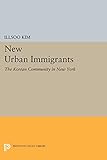New Urban Immigrants : The Korean Community in New York / Illsoo Kim.
Material type: TextSeries: Princeton Legacy Library ; 636Publisher: Princeton, NJ : Princeton University Press, [2014]Copyright date: ©1981Edition: Course BookDescription: 1 online resource (348 p.)Content type:
TextSeries: Princeton Legacy Library ; 636Publisher: Princeton, NJ : Princeton University Press, [2014]Copyright date: ©1981Edition: Course BookDescription: 1 online resource (348 p.)Content type: - 9780691614922
- 9781400855674
- 305.89570747
- F128.9.K6 -- K55 1981eb
- online - DeGruyter
- Issued also in print.
| Item type | Current library | Call number | URL | Status | Notes | Barcode | |
|---|---|---|---|---|---|---|---|
 eBook
eBook
|
Biblioteca "Angelicum" Pont. Univ. S.Tommaso d'Aquino Nuvola online | online - DeGruyter (Browse shelf(Opens below)) | Online access | Not for loan (Accesso limitato) | Accesso per gli utenti autorizzati / Access for authorized users | (dgr)9781400855674 |
Browsing Biblioteca "Angelicum" Pont. Univ. S.Tommaso d'Aquino shelves, Shelving location: Nuvola online Close shelf browser (Hides shelf browser)

|

|

|

|

|

|

|
||
| online - DeGruyter Historians and the Law in Postrevolutionary France / | online - DeGruyter Interpreting Elections / | online - DeGruyter The Imaginary Library : An Essay on Literature and Society / | online - DeGruyter New Urban Immigrants : The Korean Community in New York / | online - DeGruyter Moscow Workers and the 1917 Revolution : Studies of the Russian Institute, Columbia University / | online - DeGruyter The Late Wisconsin Spring / | online - DeGruyter The Habsburg Monarchy as a Customs Union : Economic Development in Austria-Hungary in the Nineteenth Century / |
Frontmatter -- Contents -- List of Tables -- Acknowledgments -- The Transliteration of Korean Words -- A Note on Sources -- Introduction -- Part I. The Korean Immigration to the United States -- Chapter One. United States Immigration Law as It Affects Koreans -- Chapter Two. The Formulation of South Korean Emigration Policy -- Chapter Three. South Korean Urbanization and Economic Development as They Affect Emigration -- Part II. Economic Bases of the Korean Community in the New York Metropolitan Area -- Chapter Four. Small Business as an Entry Point for Korean Immigrants -- Chapter Five. The Mobility of South Korean Medical Professionals -- Part III. The Emergence of a Korean Community -- Introduction: The Korean Community in the New York Metropolitan Area -- Chapter Six. The Church as a Basis for the Community -- Chapter Seven. Secondary Associations of the Korean Community -- Chapter Eight. The Politics of the Korean Community -- Chapter Nine. Ethnic Media as a Mechanism of Community Integration -- Part IV. The Basis of the New York Korean Community in the Historical Development of Korea -- Chapter Ten. The Origin of the Character Structure of Korean Immigrants -- Conclusion: The Future of the Korean Community in the New York Metropolitan Area -- Selective Bibliography -- Index
restricted access online access with authorization star
http://purl.org/coar/access_right/c_16ec
Insofar as the new immigration is both structurally and functionally distinct from the old immigration of peasants and artisans, the author dispenses with the traditional paradigm of a folk-to-urban transition and focuses instead on such macroscopic features as the internal political and economic problems, social structure, and foreign policy of the homeland; on the international trade, economic structure, and immigration policy of the host country; and on the special qualities of immigrants who are urban, educated, and middle class.Originally published in 1981.The Princeton Legacy Library uses the latest print-on-demand technology to again make available previously out-of-print books from the distinguished backlist of Princeton University Press. These editions preserve the original texts of these important books while presenting them in durable paperback and hardcover editions. The goal of the Princeton Legacy Library is to vastly increase access to the rich scholarly heritage found in the thousands of books published by Princeton University Press since its founding in 1905.
Issued also in print.
Mode of access: Internet via World Wide Web.
In English.
Description based on online resource; title from PDF title page (publisher's Web site, viewed 30. Aug 2021)


